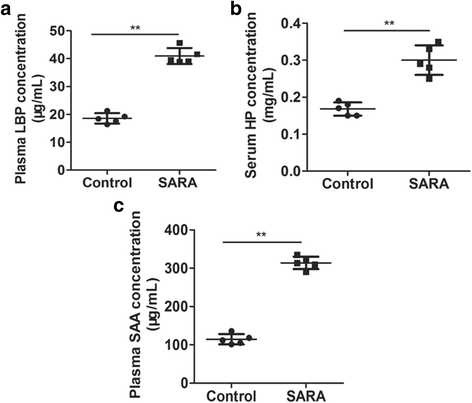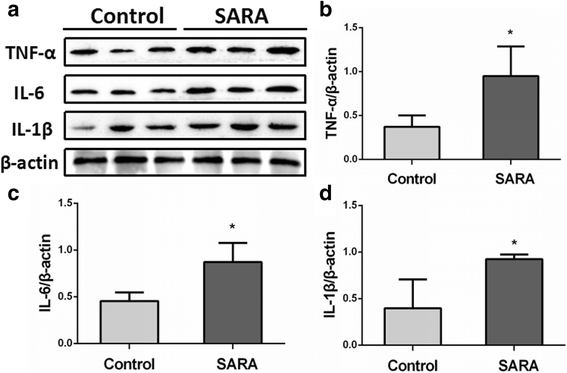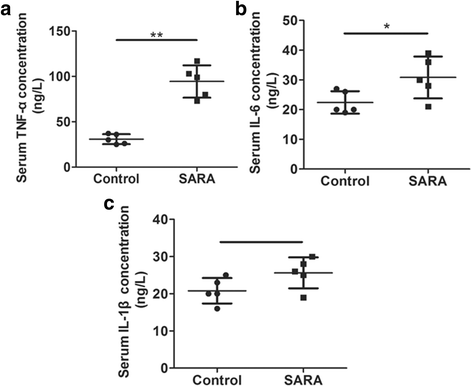Inflammatory mechanism of Rumenitis in dairy cows with subacute ruminal acidosis
- PMID: 29673406
- PMCID: PMC5909223
- DOI: 10.1186/s12917-018-1463-7
Inflammatory mechanism of Rumenitis in dairy cows with subacute ruminal acidosis
Abstract
Background: Subacute ruminal acidosis (SARA) is a metabolic disease in high-producing dairy cattle, and is accompanied by rumenitis. However, the mechanism of rumenitis remains unclear. Therefore, the aim of this study was to investigate the molecular mechanism of rumenitis in dairy cows with SARA.
Results: The results showed that SARA cows displayed high concentrations of ruminal volatile fatty acids, lactic acid and lipopolysaccharide (LPS). Furthermore, the blood concentrations of LPS and acute phase proteins haptoglobin, serum amyloid-A, and LPS binding protein were significantly higher in SARA cows than in control cows. Importantly, the phosphorylation levels of nuclear factor-kappaB (NF-κB) p65, inhibitor of NF-κB (IκB), c-Jun N-terminal kinase (JNK), and extracellular signal-regulated kinase 1/2 (ERK1/2) were significantly higher in the rumen epithelium of SARA cows than those of control cows. The ruminal mRNA and protein levels of NF-κB- and mitogen-activated protein kinase (MAPK)s -regulated inflammatory cytokines, tumor necrosis factor α (TNF-α), interleukin 6 (IL-6) and interleukin 1β (IL-1β), were markedly higher in SARA cows than in control cows. Similarly, serum concentrations of TNF-α and IL-6 were also significantly higher in SARA cows.
Conclusions: These results indicate that SARA results in high concentration of ruminal LPS, which over activates the NF-κB and MAPKs inflammatory pathways and then significantly increases the expression and synthesis of pro-inflammation cytokines in the rumen epithelium, thereby partly inducing rumenitis.
Keywords: Inflammatory pathway; LPS; Rumenitis; Subacute ruminal acidosis.
Conflict of interest statement
Ethics approval and consent to participate
The farm owner and our research team made an agreement in a written way. The ethical review committee approved this agreement. Furthermore, the study was approved by the farm owner and all experimental animals were conducted according to the International Guiding Principles for Biomedical Research. The protocol was approved by the Committee on the Ethics of Animal Experiments of the Jilin University.
Competing interests
The authors declare that they have no competing interests.
Publisher’s Note
Springer Nature remains neutral with regard to jurisdictional claims in published maps and institutional affiliations.
Figures





Similar articles
-
Histamine Induces Bovine Rumen Epithelial Cell Inflammatory Response via NF-κB Pathway.Cell Physiol Biochem. 2017;42(3):1109-1119. doi: 10.1159/000478765. Epub 2017 Jun 30. Cell Physiol Biochem. 2017. PMID: 28668950
-
Rumen-derived lipopolysaccharide provoked inflammatory injury in the liver of dairy cows fed a high-concentrate diet.Oncotarget. 2017 Jul 18;8(29):46769-46780. doi: 10.18632/oncotarget.18151. Oncotarget. 2017. PMID: 28596485 Free PMC article.
-
Ruminal lipopolysaccharide concentration and inflammatory response during grain-induced subacute ruminal acidosis in dairy cows.J Dairy Sci. 2007 Feb;90(2):856-66. doi: 10.3168/jds.S0022-0302(07)71569-2. J Dairy Sci. 2007. PMID: 17235162
-
Invited review: Effect of subacute ruminal acidosis on gut health of dairy cows.J Dairy Sci. 2022 Sep;105(9):7141-7160. doi: 10.3168/jds.2022-21960. Epub 2022 Jul 22. J Dairy Sci. 2022. PMID: 35879171 Review.
-
Subacute ruminal acidosis (SARA) challenge, ruminal condition and cellular immunity in cattle.Jpn J Vet Res. 2015 Feb;63 Suppl 1:S25-36. Jpn J Vet Res. 2015. PMID: 25872324 Review.
Cited by
-
Enhanced Autophagy in Damaged Laminar Tissue of Acute Laminitis Induced by Oligofructose Overloading in Dairy Cows.Animals (Basel). 2023 Jul 31;13(15):2478. doi: 10.3390/ani13152478. Animals (Basel). 2023. PMID: 37570287 Free PMC article.
-
Effects of Isochlorogenic Acid on Ewes Rumen Fermentation, Microbial Diversity and Ewes Immunity of Different Physiological Stages.Animals (Basel). 2024 Feb 24;14(5):715. doi: 10.3390/ani14050715. Animals (Basel). 2024. PMID: 38473100 Free PMC article.
-
Role of the Rumen Epithelium and Associated Changes Under High-Concentrate Diets.Int J Mol Sci. 2025 Mar 13;26(6):2573. doi: 10.3390/ijms26062573. Int J Mol Sci. 2025. PMID: 40141216 Free PMC article. Review.
-
Characterization of the Bacterial Community of Rumen in Dairy Cows with Laminitis.Genes (Basel). 2021 Dec 16;12(12):1996. doi: 10.3390/genes12121996. Genes (Basel). 2021. PMID: 34946945 Free PMC article.
-
Sodium Propionate Relieves LPS-Induced Inflammation by Suppressing the NF-ĸB and MAPK Signaling Pathways in Rumen Epithelial Cells of Holstein Cows.Toxins (Basel). 2023 Jul 3;15(7):438. doi: 10.3390/toxins15070438. Toxins (Basel). 2023. PMID: 37505707 Free PMC article.
References
-
- Plaizier JC, Khafipour E, Li S, Gozho GN, Krause DO. Subacute ruminal acidosis (SARA), endotoxins and health consequences. Anim Feed Sci Technol. 2012;172(1–2):9–21. doi: 10.1016/j.anifeedsci.2011.12.004. - DOI
MeSH terms
Substances
Grants and funding
LinkOut - more resources
Full Text Sources
Other Literature Sources
Research Materials
Miscellaneous

